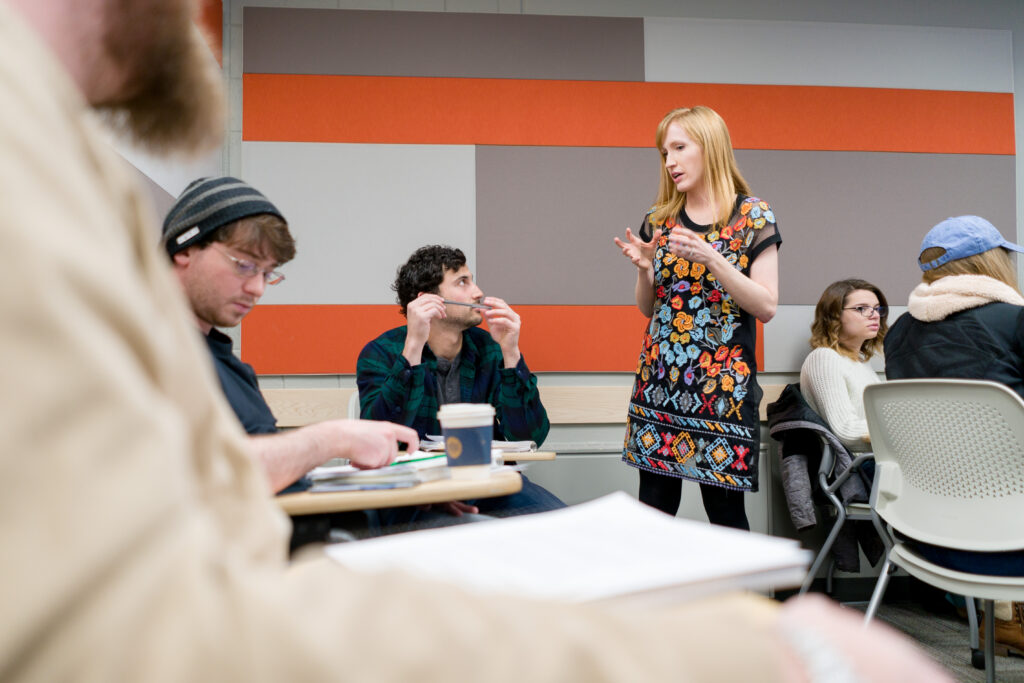Active Learning
Students benefit from a classroom structure that includes planned and purposeful opportunities to engage with content and each other. The following list includes a few considerations when planning for active learning:
- Chunk class time into 10-15 minute segments with processing time after each segment to increase learning and retention.
- Give students time and guidance to reflect about content, metacognitive processes, or study techniques.
- Increase wait-time to improve the quality and depth of student responses.
- When integrating active learning into your class, plan and practice more classroom management, figure out how to best utilize your classroom’s physical space, and consider whether or not you will want or are able to integrate teaching assistants or learning assistants into your teaching practice.
Examples of active learning strategies include:
- Classroom Assessment Techniques*
- Student-response questions
- Discussion techniques – small group, discussion protocols (Brookfield and Preskill)
- Peer reviews: Incorporate peer review protocols to facilitate the review process along with rubrics to provide constructive feedback
- Peer teaching: Give students opportunities to further process information by explaining concepts to each other.
- Case studies
- Concept mapping: Students create a visual representation of models, ideas and relationships between concepts
- Lab simulations
- Videos of guest speakers or virtual field trips
- Lab demonstrations
- Games
- Self-reflection and metacognition
- Debates or role-playing exercises
- Student-led discussions or exam-reviews
*Many of the activities recommended as in-class activities can also be homework assignments
Outside of class content processing techniques (homework)
- Authentic assignments: Ask students to do something closely related to how they will use their new knowledge in the real world. (In this video [7:26], the instructor provides examples for the students to prepare them for problems that the students will need to solve as part of the homework assignment.)
- Group assignments
- Writing assignments, wikis and blogs: Allow students to express curiosity, practice skills, process information, problem solve, and think critically.
- Conduct research
- Video presentations
- Service-Learning
- Student-generated study guides or quiz and exam questions

Additional Considerations for Teaching Online
While most of the information on teaching effectiveness pertains to both RI and online classrooms, following are a few key points for online courses.
- Not everything in your online course needs to be active. Readings and short lectures have their uses. But strategically including some active learning helps increase student motivation, and, in turn can improve students’ understanding. For example, you might intersperse readings and short lectures with games, activities and short assignments.
- It is important to keep in mind that many students take online classes because they have full-time jobs or military or family obligations that prevent them from being available at certain times. While much group work can take place asynchronously, some tools such as chats or Web conferences which are synchronous can be more difficult to manage across different time zones of your students. This isn’t to say you should never incorporate synchronous learning online, but be considerate of the reasons that students take online courses. Use synchronous learning sparingly, communicate any requirements well in advance, and be prepared to offer alternatives to students who do not have flexible schedules.
- A common fear is that the online classroom doesn’t lend itself to active learning in the same way that the RI classroom does. While it may look a little different or be asynchronous, you can use active learning in your online course just as you would in your RI course. A few ways to incorporate active learning in the online classroom are included below, but the list goes on. In short, you can do nearly everything online that you can in the classroom—you just might have to make a few tweaks to get there!
- Active Learning Strategies by Instructional Modality
- Chats
- Synchronous discussion in breakout rooms
- Short lectures interspersed with quizzes
- Let your students know which tools you will use for Communications.
- Establish an instructor audio/video presence in your course
- Set communication norms/expectations
- Authentic assignments. (In this video [15:00], the instructor and a helper play the roles of therapist and client. Students are asked to critique the therapist’s strengths and areas for improvement in a discussion forum.)

